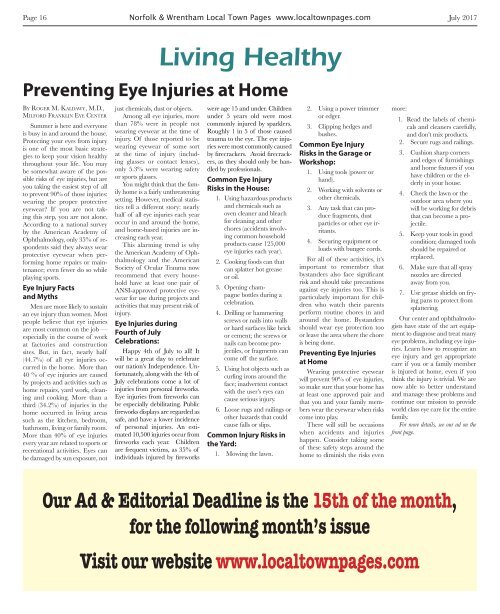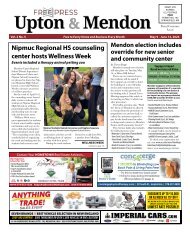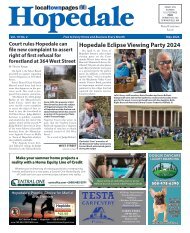You also want an ePaper? Increase the reach of your titles
YUMPU automatically turns print PDFs into web optimized ePapers that Google loves.
Page 16 <strong>Norfolk</strong> & <strong>Wrentham</strong> Local Town Pages www.localtownpages.com <strong>July</strong> <strong>2017</strong><br />
Living Healthy<br />
Preventing Eye Injuries at Home<br />
By Roger M. Kaldawy, M.D.,<br />
Milford Franklin Eye Center<br />
Summer is here and everyone<br />
is busy in and around the house.<br />
Protecting your eyes from injury<br />
is one of the most basic strategies<br />
to keep your vision healthy<br />
throughout your life. You may<br />
be somewhat aware of the possible<br />
risks of eye injuries, but are<br />
you taking the easiest step of all<br />
to prevent 90% of those injuries:<br />
wearing the proper protective<br />
eyewear? If you are not taking<br />
this step, you are not alone.<br />
According to a national survey<br />
by the American Academy of<br />
Ophthalmology, only 35% of respondents<br />
said they always wear<br />
protective eyewear when performing<br />
home repairs or maintenance;<br />
even fewer do so while<br />
playing sports.<br />
Eye Injury Facts<br />
and Myths<br />
Men are more likely to sustain<br />
an eye injury than women. Most<br />
people believe that eye injuries<br />
are most common on the job —<br />
especially in the course of work<br />
at factories and construction<br />
sites. But, in fact, nearly half<br />
(44.7%) of all eye injuries occurred<br />
in the home. More than<br />
40 % of eye injuries are caused<br />
by projects and activities such as<br />
home repairs, yard work, cleaning<br />
and cooking. More than a<br />
third (34.2%) of injuries in the<br />
home occurred in living areas<br />
such as the kitchen, bedroom,<br />
bathroom, living or family room.<br />
More than 40% of eye injuries<br />
every year are related to sports or<br />
recreational activities. Eyes can<br />
be damaged by sun exposure, not<br />
just chemicals, dust or objects.<br />
Among all eye injuries, more<br />
than 78% were in people not<br />
wearing eyewear at the time of<br />
injury. Of those reported to be<br />
wearing eyewear of some sort<br />
at the time of injury (including<br />
glasses or contact lenses),<br />
only 5.3% were wearing safety<br />
or sports glasses.<br />
You might think that the family<br />
home is a fairly unthreatening<br />
setting. However, medical statistics<br />
tell a different story: nearly<br />
half of all eye injuries each year<br />
occur in and around the home,<br />
and home-based injuries are increasing<br />
each year.<br />
This alarming trend is why<br />
the American Academy of Ophthalmology<br />
and the American<br />
Society of Ocular Trauma now<br />
recommend that every household<br />
have at least one pair of<br />
ANSI-approved protective eyewear<br />
for use during projects and<br />
activities that may present risk of<br />
injury.<br />
Eye Injuries during<br />
Fourth of <strong>July</strong><br />
Celebrations:<br />
Happy 4th of <strong>July</strong> to all! It<br />
will be a great day to celebrate<br />
our nation’s Independence. Unfortunately,<br />
along with the 4th of<br />
<strong>July</strong> celebrations come a lot of<br />
injuries from personal fireworks.<br />
Eye injuries from fireworks can<br />
be especially debilitating. Public<br />
fireworks displays are regarded as<br />
safe, and have a lower incidence<br />
of personal injuries. An estimated<br />
10,500 injuries occur from<br />
fireworks each year. Children<br />
are frequent victims, as 35% of<br />
individuals injured by fireworks<br />
were age 15 and under. Children<br />
under 5 years old were most<br />
commonly injured by sparklers.<br />
Roughly 1 in 5 of those caused<br />
trauma to the eye. The eye injuries<br />
were most commonly caused<br />
by firecrackers. Avoid firecrackers,<br />
as they should only be handled<br />
by professionals.<br />
Common Eye Injury<br />
Risks in the House:<br />
1. Using hazardous products<br />
and chemicals such as<br />
oven cleaner and bleach<br />
for cleaning and other<br />
chores (accidents involving<br />
common household<br />
products cause 125,000<br />
eye injuries each year).<br />
2. Cooking foods can that<br />
can splatter hot grease<br />
or oil.<br />
3. Opening champagne<br />
bottles during a<br />
celebration.<br />
4. Drilling or hammering<br />
screws or nails into walls<br />
or hard surfaces like brick<br />
or cement; the screws or<br />
nails can become projectiles,<br />
or fragments can<br />
come off the surface.<br />
5. Using hot objects such as<br />
curling irons around the<br />
face; inadvertent contact<br />
with the user’s eyes can<br />
cause serious injury.<br />
6. Loose rugs and railings or<br />
other hazards that could<br />
cause falls or slips.<br />
Common Injury Risks in<br />
the Yard:<br />
1. Mowing the lawn.<br />
2. Using a power trimmer<br />
or edger.<br />
3. Clipping hedges and<br />
bushes.<br />
Common Eye Injury<br />
Risks in the Garage or<br />
Workshop:<br />
1. Using tools (power or<br />
hand).<br />
2. Working with solvents or<br />
other chemicals.<br />
3. Any task that can produce<br />
fragments, dust<br />
particles or other eye irritants.<br />
4. Securing equipment or<br />
loads with bungee cords.<br />
For all of these activities, it’s<br />
important to remember that<br />
bystanders also face significant<br />
risk and should take precautions<br />
against eye injuries too. This is<br />
particularly important for children<br />
who watch their parents<br />
perform routine chores in and<br />
around the home. Bystanders<br />
should wear eye protection too<br />
or leave the area where the chore<br />
is being done.<br />
Preventing Eye Injuries<br />
at Home<br />
Wearing protective eyewear<br />
will prevent 90% of eye injuries,<br />
so make sure that your home has<br />
at least one approved pair and<br />
that you and your family members<br />
wear the eyewear when risks<br />
come into play.<br />
There will still be occasions<br />
when accidents and injuries<br />
happen. Consider taking some<br />
of these safety steps around the<br />
home to diminish the risks even<br />
more:<br />
1. Read the labels of chemicals<br />
and cleaners carefully,<br />
and don’t mix products.<br />
2. Secure rugs and railings.<br />
3. Cushion sharp corners<br />
and edges of furnishings<br />
and home fixtures if you<br />
have children or the elderly<br />
in your house.<br />
4. Check the lawn or the<br />
outdoor area where you<br />
will be working for debris<br />
that can become a projectile.<br />
5. Keep your tools in good<br />
condition; damaged tools<br />
should be repaired or<br />
replaced.<br />
6. Make sure that all spray<br />
nozzles are directed<br />
away from you.<br />
7. Use grease shields on frying<br />
pans to protect from<br />
splattering.<br />
Our center and ophthalmologists<br />
have state of the art equipment<br />
to diagnose and treat many<br />
eye problems, including eye injuries.<br />
Learn how to recognize an<br />
eye injury and get appropriate<br />
care if you or a family member<br />
is injured at home, even if you<br />
think the injury is trivial. We are<br />
now able to better understand<br />
and manage these problems and<br />
continue our mission to provide<br />
world class eye care for the entire<br />
family.<br />
For more details, see our ad on the<br />
front page.<br />
Our Ad & Editorial Deadline is the 15th of the month,<br />
for the following month’s issue<br />
Visit our website www.localtownpages.com

















